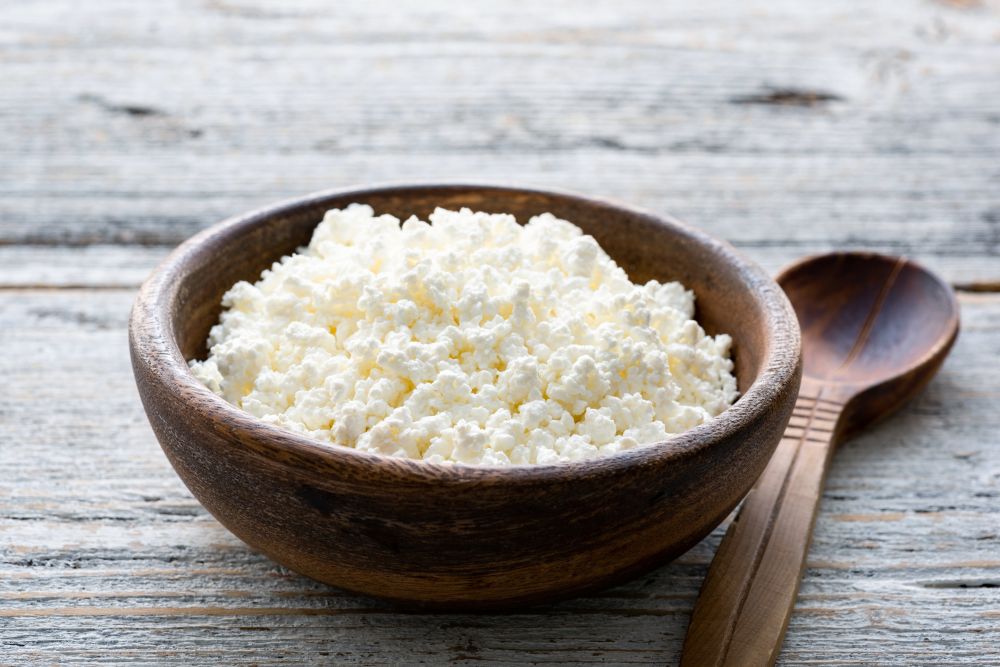Can You Freeze Cottage Cheese? Learn How to Do This the Right Way
Cottage cheese and baked sweet potato, yum that is one of my favorite lunches!
This soft and creamy cheese is full of flavor, proteins, and essential nutrients that will make you fall in love with your lunch; the challenge will be to try and resist eating your lunch at 10 am (smile..).
Is Cottage Cheese Good for You?
Cottage cheese is not only delicious in baked potatoes, but it also goes well with waffles, pancakes, salads, fruit bowls, dipping sauces, granola, smoothies, toast, and whatnot.
You can even include cottage cheese in your freezer-meal varieties.
Some cottage cheese keto meal ideas include low-carb cottage cheese and egg salad, low-carb cottage cheese muffins, cottage cheese pancakes, cottage cheese alfredo, cottage cheese casserole, and many others.
With so much versatility I am always buying this cheese in large quantities. This got me thinking one day, can I freeze cottage cheese? The answer is yes, you can freeze cottage cheese for up to 3 months. However, the texture will change, making it unsuitable to eat as a topping, but perfect for a cooked dish!
Are you wondering if the same answer applies to dry cottage cheese? Keep on reading as we answer this and many other cottage cheese questions!
Can You Freeze Cottage Cheese

Often, people try to store cottage cheese to make life easier, believing they’ll have a stock ready when the occasion calls for it.
The truth is that if you try to freeze any cheese, including sour cream, cottage cheese, or cream cheese, you will experience a drastic change in its texture.
Cheese, after freezing, separates and turns crumbly if it was hard initially or becomes crystallized if it was soft. Nothing specifies you can’t freeze cottage cheese; it can still be done. However, it would be best to prepare for the texture change and alterations in the flavor.
It is best to buy or prepare only as much cottage cheese as you need, and keep it in the fridge if your intention is to use it as a topping or snack.
Now cottage cheese in its original state does not work well if frozen, but if you’re incorporating it into cooked dishes like lasagna or quiche, the meal can totally be frozen.
Once you defrost or thaw lasagna in your microwave, you won’t notice a big change in the texture or taste as it combines with the meat sauce.
Similarly, it is also possible to freeze a quiche with cottage cheese in it for approximately two or three months. If you plan to add the cottage cheese in an unbaked quiche and one you will only assemble after it thaws, do not freeze for more than a month.
Can You Freeze Dry Cottage Cheese

Yes you can freeze dry cottage cheese for up to 6 months, and what is more, it freezes well; the curds get lighter. However, the cheese will also be drier so you will need to hydrate it with a little bit of milk or cream. I like it either way, so you will have to experiment and decide which is your preferred option if any.
For those that do not know what dry cottage cheese is; it is the same as regular cottage cheese, but it lacks the milk or cream content.
Meaning once a person curdles the milk for dry cottage cheese, they do not have to add any additional liquid additives such as cream or milk.
Not many grocery stores offer the dry cottage cheese variety so you may have to head to a farmers’ market, a health food store, or make it at home.
Dry Cottage Cheese Recipe
Step 1

Pour 1 gallon (3.7 L) of milk and ½ cup of powder milk into a pot
Step 2

Place the milk on the stove at high to medium heat. Ensure the milk does not boil.
Step 3
Once the milk has reached a lukewarm temperature, add 1 cup of buttermilk.
Step 4

Cook on low heat for 12 hours, or until several cheese curds have been formed
Step 5
Raised the heat until no moisture is still visible
Step 6

Place a cheesecloth over a colander and gently tip the curdle milk.
Buy your cheesecloth from Amazon. This cheesecloth is economical, durable, reusable, and of high quality. What more would you want!
Step 7
Once all the moisture has been drained, rinse the cottage cheese under running water until it has cooled down
Step 8
Drain and dry the curds once more
Step 9
Place the curds on the cheesecloth and add 2 teaspoons of salt to the cottage cheese
Step 10

Wrap the cheese once again on the cheesecloth and leave it undisturbed for a 1 hour
Voile you have dry cottage cheese!
How to Defrost Cottage Cheese?
How to defrost cottage cheese depends on how much time you can spare for the thawing process, but this can either be with water or in the refrigerator, avoid the microwave.
Water
- If you wish to speed up the process a little bit, place the frozen cottage cheese into a waterproof container.
- Then, place the bag/container in a bowl full of cold water (make sure the whole bag/container is covered with water).
- Change the water every 30 minutes until the cheese is fully defrosted. This will ensure the water remains cold.
- This could take 2 to 3 hours for the cheese to defrost.
Warning: Never use warm water to thaw your cottage cheese as this will induce bacteria growth.
Refrigerator

In the refrigerator, the whole process takes approximately 24 to 48 hours.But it is the safest way to defrost your cottage cheese because the food will never reach the danger zone.
The danger zone occurs when foods reach an internal temperature between 40 – 140 °F (4.5 – 60 °C), the prime temperature for the natural bacteria in the food to start multiplying very fast in great quantities potentially causing food poisoning.
Although using the refrigerator to defrost your cottage cheese takes longer than using water, the thawing process is safer and allows it to retain some of its moisture content in the packaging preserving its natural flavors.
Whether you choose to defrost your cottage cheese in water or in the refrigerator, it is advisable to ensure the cheese is fully defrosted before you use it on your meal, to prevent the curds from separating in the cooking process.
Can You Defrost Cottage Cheese In The Microwave

No, do not defrost cottage cheese in the microwave. This can lift the whey from the cheese, leaving it oily and unpalatable.
Cottage cheese is made by draining the cheese instead of pressing it, allowing it to retain some of the whey.
Is this why that keeps the cottage cheese moist, even after it has been frozen, removing it will simply leave the cheese oily!
Is Cottage Cheese Good After Being Frozen?

Yes, cottage cheese is good after being frozen as you will not lose any of the nutrients in the cheese.
However, it will not be suitable to eat alone or as a topping as the texture and flavor change in the freezing process.
It can however be used in hot dishes such as pasta, lasagna, quiches, and more!
How Do You Make Cottage Cheese Last Longer

Place your cottage cheese container upside down in the fridge. You can use this tip to maximize the shelf life of not only your cottage cheese but also sour cream.
We all know that these two products, even if homemade, do not have a very long shelf life. But you can make them last a wee bit longer by placing your cottage cheese container and even that of sour cream upside down in the fridge.
When you invert the tub this way, you create a vacuum effect. This, in turn, helps stifle bacteria growth and keeps the food from turning bad.
The other way of conserving your cottage cheese is to transfer the unused portion into a glass jar. Ensure this has a tight screw on the lid, this will preserve your cottage cheese a little longer.
Conclusion
Cottage cheese is a product that forms with fresh curds. It has a mild flavor but packs many essential nutrients for the body. It is also a good source of healthy fats. Many refer to cottage cheese as whey and curds, but it is not aged. You merely have to drain the cheese and not press it as required in other dairy products like paneer.
You can also freeze cottage cheese in portions, so long as you intend to use it for sauces, dips, and cooking purposes. The change in texture and color are usually not noticeable in such uses. However, if you plan to use cottage cheese for your breakfast toasts, then we suggest using frozen dry cottage cheese.
Rest assured, this dairy product is a great addition to most of your side meals and even entrees when you want to feed your family nutritious food.


